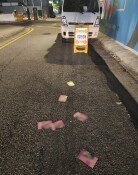Taxi and Bus Drivers Go on Strike, Transportation System Crippled
Taxi and Bus Drivers Go on Strike, Transportation System Crippled
Posted June. 29, 2003 22:18,
Entering the second day of railway workers` strike, only about 80% of trains on Seoul-Incheon/Suwon, Seoul-Sungnam and Seoul-Uijeongbu routes were in operation on June 29.
Operations of Line 1, which is heavily dependent on trains at the Korea Railway Corporation, had to extend intervals between trains from 2 to 6 minutes to up to 30 minutes, crowding platforms along the way.
The interval on the Seoul-Incheon/Suwon route was extended from 9 to 16 minutes, and that on the Yongsan-Cheongryangri route from 13 to 27 minutes. Passengers were complaining about the delays, with some calling for refund.
At Jongro Street 3 Station, passengers rushed into Line 5 platform after waiting for a train on Line 1, crowding the platform and trains.
Apart from a general strike joined by taxi drivers and some city bus drivers, the Federation of Korea Trade Unions now plans to hold a street rally at downtown Seoul on June 30, calling for introduction of the five-day workweek system, With the large demonstrations, transportation at the nation`s largest city will likely further be crippled on Monday.
Train Operations Remain Low
With most passengers avoiding using trains, the strike did not lead to chaos in the transportation system on the first day. Without knowing about the strike, however, some came to train stations and later complained and called for refund.
Operations of Samaeul trains were all canceled at one time and remained low as 32 percent on the day even after the corporation managed to dispatch two trains in the morning.
Operations of Mugunghwa trains were also as low as 20% of normal, with only 34 trains out of the total 162 in operations. 4 out of 20 trains assigned for Gyeongui Line (Seoul-Munsan) were operating.
The number of people using express buses and airplanes increased by 60% and 10% respectively, with passengers seeking to find alternatives.
Gangnam Bus Terminal was crowded with travelers leaving for southern cities such as Busan and Daegu.
I took a taxi not to be late for my train, not knowing about the cancellation, said 34-year-old Kim. The railway corporation should not have received reservations in the first place facing a major strike.
Government Take Actions
The government plans to increase the number of city and long-distance buses, which have similar routes with Subway Line 1, 3 and 4, during rush hours, while dispatching shuttle buses connecting major satellite cities and Seoul.
813 buses connecting Seoul and outskirt cities will be in operations, and operation hour of town buses carrying subway and train users will be extended by one hour.
20 free shuttle buses will cover Mt. Dobong Station-Jongro Street 5, Gia Bridge-Guro Station and Onsu-Sindorim routes. The government is also considering mobilize some 14,130 taxies.
The Incheon City plans to increase the number of buses connecting Seoul and Suwon from 461 to 511, and dispatch buses connecting Incheon-Juan Station-Shindorim at 15 to 20 minute intervals and East Incheon-Bupyong Station-Seoul Station at 4 to 5 minute intervals.
The Gyeonggi government has also decided to increase the number of city buses and long-distance buses from 2,496 to 2,750 and from 1,647 to 1,770 respectively.





![반찬통 착색 고민 끝…‘두부용기’ 버리지 말고 이렇게 쓰세요 [알쓸톡]](https://dimg.donga.com/c/138/175/90/1/wps/NEWS/IMAGE/2026/01/09/133126593.3.png)

